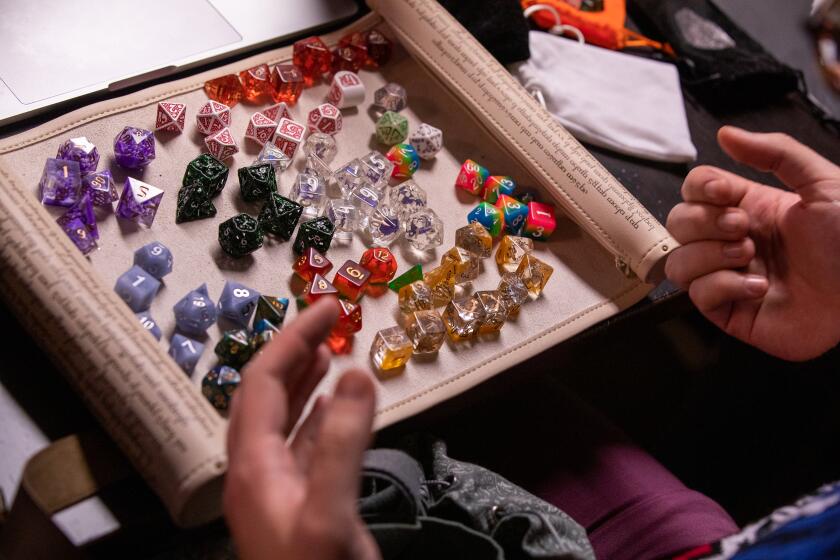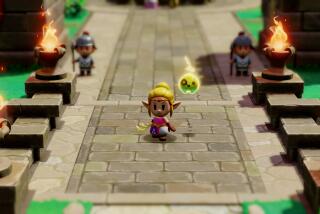The dose of self-care you didn’t know you needed? Playing the new ‘Super Mario Bros. Wonder’

- Share via
Early on in “Super Mario Bros. Wonder,” nemesis Bowser, up to no good in a new kingdom, transforms himself into a heavy metal-loving sentient castle. Mario and Co. need to come to the rescue. But before the run-and-jump platforming action begins, a little yellow flower has a message for Team Mario: “I believe in youuu!” it says in a chirpy, sing-songy voice.
The statement arrives like a hug. And there will be more.
Throughout the game, flowers cheer us on, sometimes commenting existentially on the scenery, and sometimes just saying, “Way to go!” before the screen erupts in a giant fireworks display. You can turn the flowers off, but I don’t know why anyone would want to. Their sense of constant amazement at what is happening is really what the best “Super Mario Bros.” games are all about, and “Wonder” doesn’t disappoint.
“Super Mario Bros. Wonder” arrived last week at a time of renewed interest in the Nintendo mascot, thanks in part to the success of “The Super Mario Bros. Movie” and the U.S. opening of Super Nintendo World at Universal Studios Hollywood. It could be seen as a return to tradition, as it’s the first traditional side-scrolling “Super Mario Bros.” game in 11 years, but despite familiar foes and save-the-kingdom objectives, it is a game full of surprises — not to mention magical fruits and flowers that play with our expectations of what a “Mario” game can be.
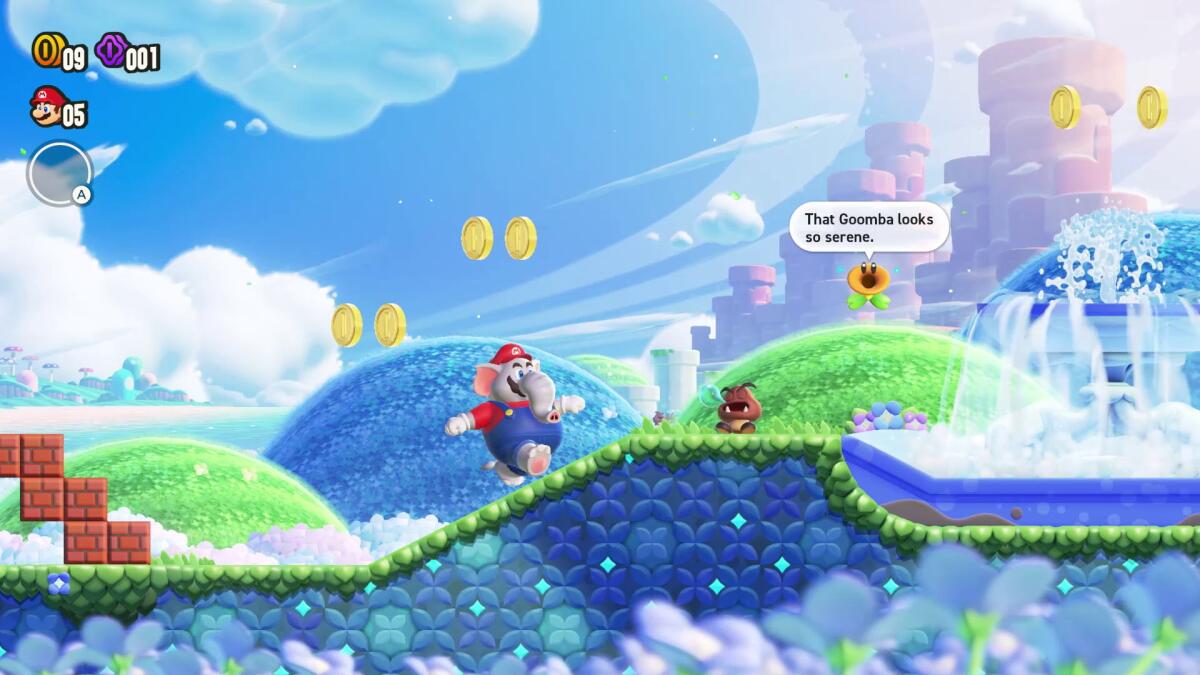
“Super Mario Bros.” games are often seen as lighthearted fare, interactive works about play for play’s sake. But “Super Mario Bros. Wonder” was a reminder to me that they’re much deeper than that. With revelations like the emotional support flowers appearing throughout the surreal world, the game is a treatise on the healing power of play.
The game arrived at what’s been the end of one of the most difficult years of my life, reeling still from the long-lasting heartbreak caused by a traumatic breakup. But almost everyone I know is struggling with something, be it the violently horrific recent events around the globe, seemingly never-ending rising costs of pretty much everything or just the realities of what it takes to survive in 2023. For me, therapy has helped, and so has being open to small ounces of brightness throughout my day. If you’re looking for some practice with the latter, I’d recommend trying Nintendo’s “Super Mario Bros. Wonder.”
Southern California is filled with gorgeous Buddhist temples, meditation gardens, churches and synagogues that inspire awe. Here are some worth a visit. Get ready to be wowed.
For this is a game less about challenges and more about life — why we explore, how we stay optimistic and, most importantly, how we can find awe in unexpected places. Playing it has been akin to injecting pure serotonin, and I’d argue it’s done more to boost my mood than any of the self-help audio books I’ve devoured over the last 11 months.
I won’t go as far as to compare it to any of those texts, but “Super Mario Bros. Wonder” is the video game of self-care. It is at once a love letter to the unexpected — a signature feature of the game is Mario’s ability to turn into an elephant, water-slinging trunk and all, after devouring a piece of fruit — and a reminder that the bizarre surrounds us everyday, as long as we don’t shut off our imagination.
I’ve returned, for instance, throughout my playthrough to an early level featuring a bounty of Piranha Plants, those chomping, polka-dotted, Mario-biting flora that have long been a staple of the series. Only here, they walk, and at one point in the level can break into song. “They’re singing!” exclaims our flower pal, and indeed they are, with a high-pitched, childlike voice. They string together nonsense syllables into a melody that could be heard as a twisted Christmas song.
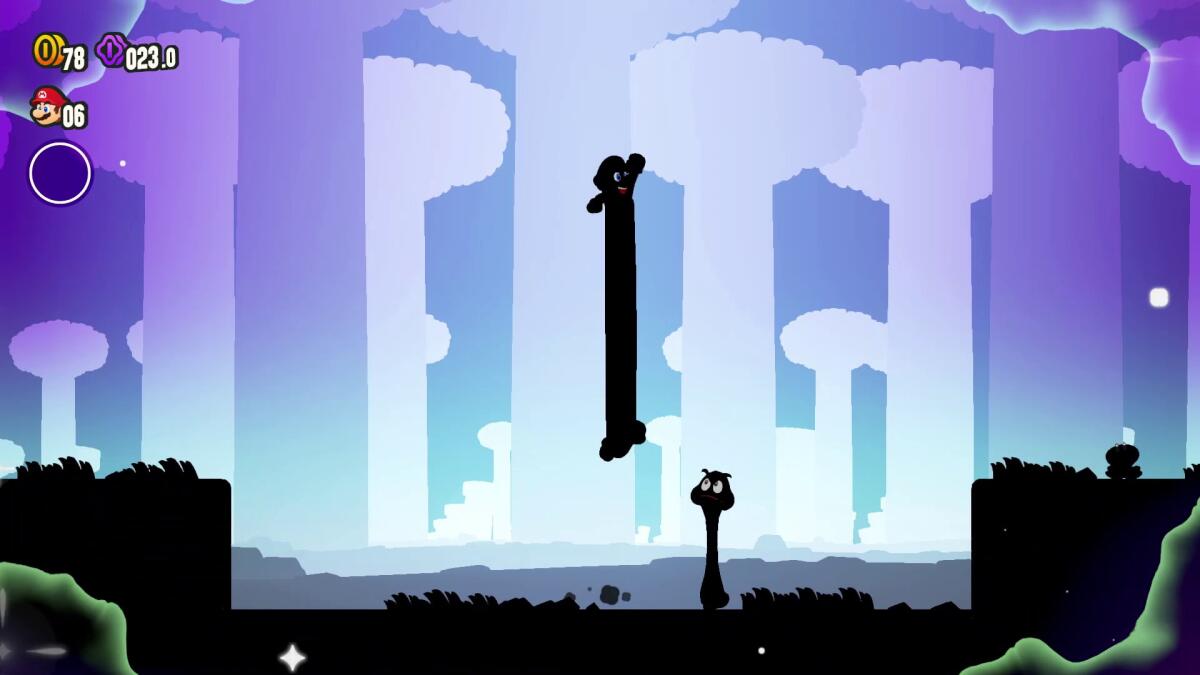
It’s an easy, early level, but I revisit it because it never fails to make me smile, and it serves as a reminder that the so-called ordinary is often extraordinary if we’re willing to pay attention. My instinct here is to stop, watch and listen, despite the fact that they still want to eat Mario.
There are so many of these whimsical moments that the game has made me rethink how and where we can find awe. We can, I believe, find it in a video game, at least one that is full of constant ideas, never-ending surrealness and inviting, approachable play.
Awe, in the scientific sense, is the “feeling of being in the presence of something vast that transcends your current understanding of the world,” as defined by Dacher Keltner, a psychology professor and the author of “Awe: The New Science of Everyday Wonder and How It Can Transform Your Life.” Keltner argues that awe can be found in the day-to-day, be it in nature, the moral beauty of others or encounters with art, music and film.
In about 10 hours with the game, my Nintendo Switch is filled with now hundreds of screenshots of various “Super Mario Bros. Wonder” levels, many of them pics that capture the talking flowers midsentence (“I wonder what seawater tastes like,” muses one). But they also serve as little postcards, messages to myself that play itself can be a way to look at our surroundings.
Give yourself a play break! Tabletop games abound at these bars, game shops and cafes in Los Angeles and Orange counties.
Each level in “Super Mario Bros. Wonder” seems to build upon and tweak the rules of the prior one. Sometimes the floor is gooey, and seems to shrink when we stand on it. Other times it becomes an actual countdown timer, threatening to disappear with each jump from our plucky, plump plumber Mario.
Sometimes we build the ground as we go, pounding blocks above us to send them flying in front of us. Such attention to detail is how I explain that I, in what’s been an extended depressed state, suddenly stood transfixed by the agate swirls found in the travertine walls of the Natural History Museum last weekend, or got lost the other week by the moon-like shadows on downtown Los Angeles sidewalks inspired by an eclipse. Cracks and crevices became hidden patterns, and our walls, floors, ceilings and sidewalks are filled with designs worthy of an astrologer’s star map. That is, if we just stop to absorb them.
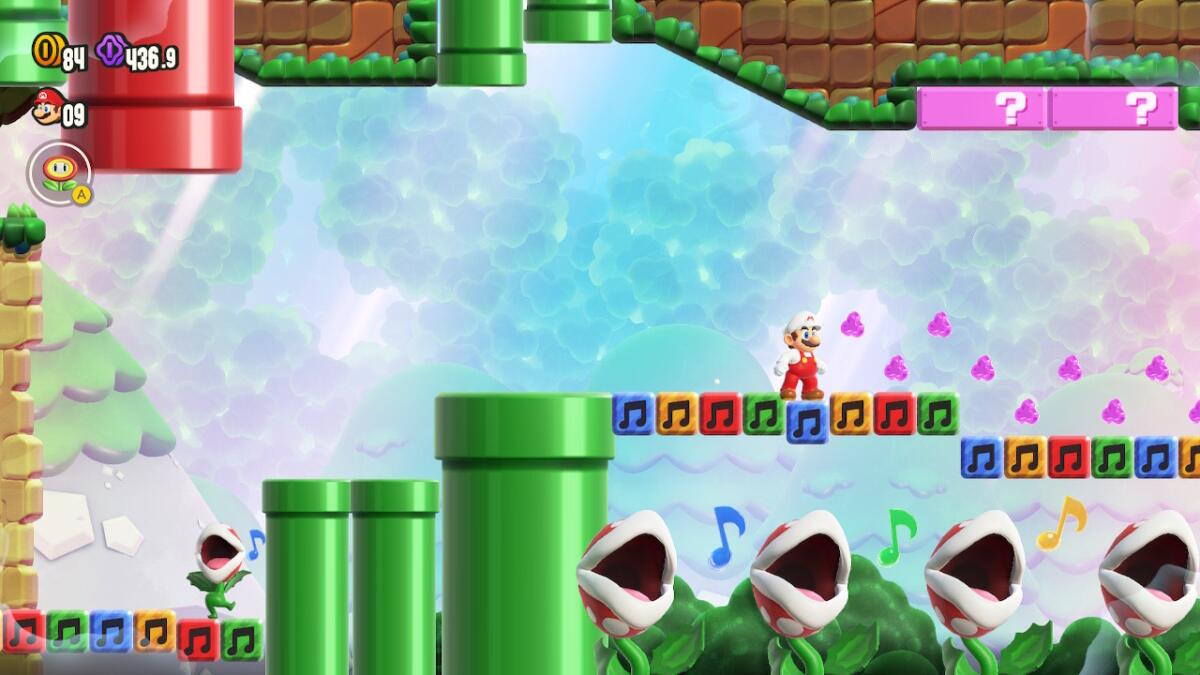
A key component of “Super Mario Bros. Wonder” is the so-called the “Wonder Flower,” which, when collected, essentially turn the world on its head. Piranha Plants, for instance, start singing, or we’re suddenly gliding through a cosmic downpour trying to avoid lighting strikes (“What a rush!,” shouts a flower friend).
Everything we’ve come to know about a “Super Mario Bros.” game is momentarily twisted and turned — at once Mario is zooming on a track, transformed into a spike-enhanced slug. They’ve been described as something akin to an acid trip, but I’d argue they’re more like a wake-up call, a gentle knock on the head that says we should workout our imaginations as much as we do our bodies.
Video games, as interactive texts requiring active participation, are uniquely positioned to make that argument, and the “Super Mario Bros” series has been riding that thesis for nearly four decades. Mario is often seen as a cipher, someone who’s only as interesting as his transformations, be it in the past into a feline-like prowler or a spinning top of an avatar with a raccoon-like tail. But he’s really someone who’s guided by his curiosity, essentially saying in “Wonder,” “Yes, I will eat that fruit that turns me into an elephant,” or, “Absolutely, I will devour that flower that allows bubbles to shoot from my hands.”
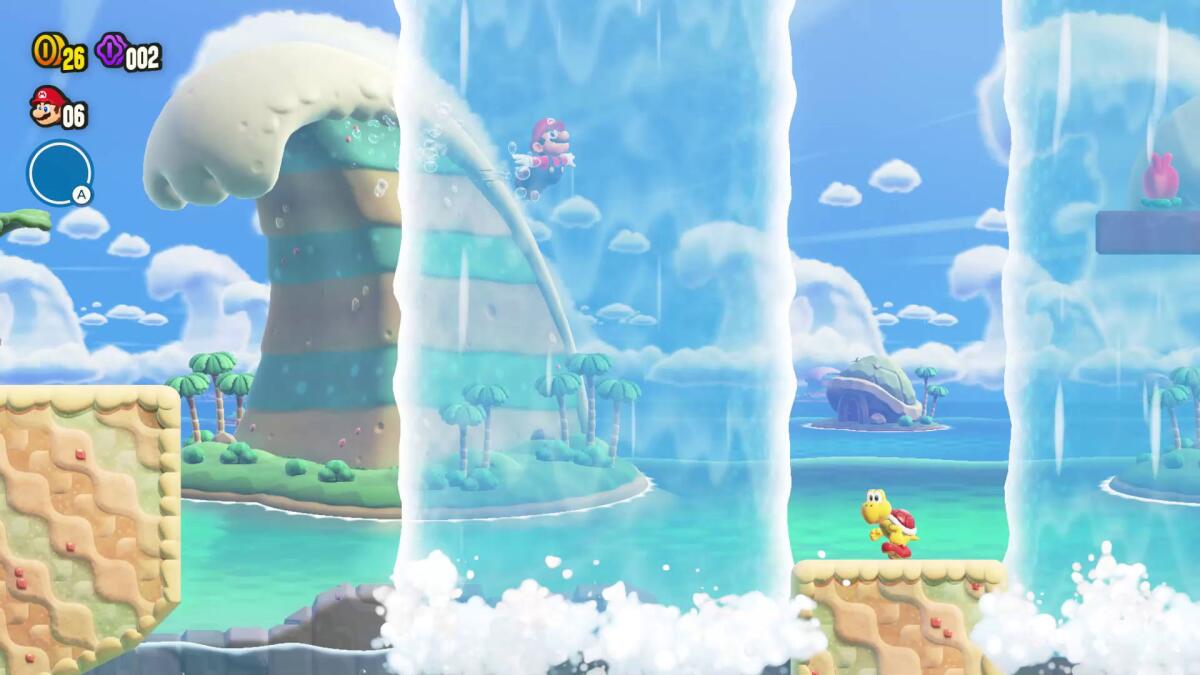
It’s a zest for life that’s more familiar than psychedelic simply because it’s so childlike; we can, in other words, all relate, or remember a time when we could see ourselves as anything and anyone, a worldview in which it makes sense that we can shape-shift into an elephant or a castle. Sprung from the mind of game design master Shigeru Miyamoto — “Wonder” was overseen by longtime Miyamoto collaborator Takashi Tezuka — it’s often been said that the initial “Super Mario Bros.” title was inspired by childhood playgrounds. But as Mario has evolved and his worlds have gotten bigger, brighter and more colorful, they’ve also become about something bolder.
As I steered Mario to stand on a cloud, one of fluffy whiteness and welcoming eyes, a turtle with angelic wings flew toward him while an island designed to mimic an oceanic wave stood in the background. A storm cloud, one Mario could essentially swim through, stood before our hero in his trademark red suspenders. Then a talking flower chimed in. “They say the ocean tastes like tears,” it said, and I directed Mario to jump in place and then stop and stand still.
A flood of memories from the last two years of my life came rushing through — some positive, some melancholic and most in-between — as I thought about tears and travels and afternoons near the ocean spent on Santa Monica amusement park rides. The interactive digital world I was looking at had evoked joy, nostalgia and a little heartbreak, and its outlandish weirdness suddenly felt familiar, an extraordinary world that was as ordinary yet magnificent as our own.
More to Read
Sign up for The Wild
We’ll help you find the best places to hike, bike and run, as well as the perfect silent spots for meditation and yoga.
You may occasionally receive promotional content from the Los Angeles Times.

